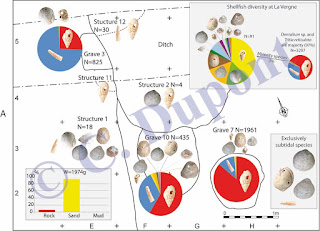Personal adornments and objects of ornamentation: two case studies from hunter-gatherer burials, in France (La Vergne) and Argentina (Arroyo Seco II).
Laporte l., Dupont C., 2019 - Personal adornments and objects of ornamentation: two case studies from hunter-gatherer burials, in France (La Vergne) and Argentina (Arroyo Seco II). PaleoAnthropology, 156−176. ISSN 1545-0031, doi:10.4207/PA.2019.ART129, http://www.paleoanthro.org/media/journal/content/PA20190156.pdf
This article presents two case studies from totally distinct geographic
sectors and cultural environments: the Arroyo Seco II cemetery, in the
Pampas in Argentina (7800-6300 BP and 4800-4300 BP), and La Vergne, in
the west of France dated to the Early Mesolithic (9280- 9000 BP), on
opposite sides of the Atlantic Ocean. These two graveyards correspond to
hunter-gatherer populations, where shells are a major component. They
present exceptionally well-conserved remains and were attentively and
accurately excavated. Burial environments such as these, especially
graves in open ground, enable us to discuss the status of decorative and
ornamental objects in relation to the deceased, and their position in
the tomb. Some of them contain abundant corporal personal adornments,
whereas others seem to correspond to the deposition of objects in highly
ornate perishable materials; each of which contributes to the funerary
arrangements. The comparison of such distant examples compels us to go
beyond strictly local contingencies and allows us to better underline
similarities. It also provides the opportunity to bring to light
different types of human action on materials, including the comparison
of natural entities with the shaping of raw materials. With respect to
prehistoric personal adornments, this debate is reminiscent of the
earlier distinction between shells (skeletal) and shellfish. Within this
comparative scheme, a new example - the Germignac grave complex (6090
BP) from the early Neolithic of western France where shells are also a
major component of adornments - will then highlight how the first
farmers, at least in this case, erased the natural identity of certain
elements.
La Vergne, France: A) In spite of the binary composition of the adornments, each tomb can be clearly identified on the basis of the type of represented shellfish species (CAD by C. Dupont and L. Quesnel)



